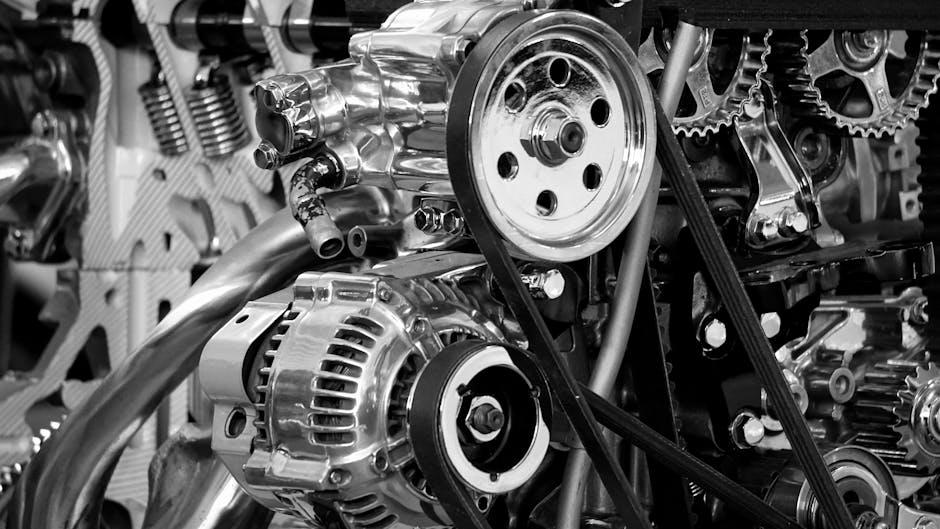In the world of driving, the choice between automatic and manual transmissions often sparks passionate debates among car enthusiasts and everyday drivers alike. Beyond the thrill of shifting gears or the ease of seamless acceleration, lies an equally important aspect that keeps your vehicle running smoothly: maintenance. Whether you swear by the simplicity of an automatic or the control of a manual, understanding the unique care each transmission demands can save you from costly repairs and extend the life of your ride. This article ventures into the realm of automatic versus manual transmission, offering practical maintenance tips tailored to each, helping you navigate the road to optimal performance with confidence and clarity.
Table of Contents
- Understanding the Core Differences in Transmission Maintenance
- Essential Fluid Checks and Changes for Automatic and Manual Transmissions
- Identifying Early Warning Signs and Addressing Common Issues
- Best Practices for Extending the Life of Your Transmission
- DIY Maintenance Tips Versus Professional Servicing Insights
- Balancing Cost Efficiency and Performance in Transmission Care
- Q&A
- Key Takeaways

Understanding the Core Differences in Transmission Maintenance
Automatic and manual transmissions operate on fundamentally different mechanical principles, which directly impact their maintenance needs. Automatic transmissions rely on complex hydraulic systems and a fluid called transmission fluid to lubricate and cool the moving parts. This fluid degrades over time and requires periodic replacement to prevent overheating and wear. Conversely, manual transmissions primarily depend on gear oil for lubrication, which tends to have a longer service life but still demands inspection to avoid gear grinding and clutch issues.
Maintaining either transmission type involves vigilance but differs in focus areas. For automatics, key tasks include:
- Regular transmission fluid checks and changes to ensure smooth shifting and prevent slipping.
- Monitoring for unusual noises or vibrations that may hint at internal wear or hydraulic problems.
- Inspecting cooling systems to avoid overheating during heavy or extended use.
Manual transmissions emphasize:
- Clutch system inspection and adjustment to maintain optimal engagement and prevent slippage.
- Checking gear oil levels and condition for effective gear synchronization and smooth shifting.
- Listening for gear noise or difficulty in shifting as early warnings of mechanical wear.
| Maintenance Aspect | Automatic Transmission | Manual Transmission |
|---|---|---|
| Fluid Type | Transmission fluid | Gear oil |
| Service Interval | Every 30,000-60,000 miles | Every 60,000-100,000 miles |
| Common Checks | Fluid level, temperature, shifting smoothness | Clutch condition, gear oil, shift performance |

Essential Fluid Checks and Changes for Automatic and Manual Transmissions
Maintaining the right fluid levels and changing them at the appropriate intervals are critical for the longevity and performance of both automatic and manual transmissions. Automatic transmissions require transmission fluid that acts not only as a lubricant but also as a hydraulic fluid to facilitate smooth gear shifts. Over time, this fluid can degrade, becoming contaminated with particles and losing its effectiveness. Regularly checking the fluid level and quality—looking out for dark or burnt-smelling fluid—is essential to avoid costly repairs. Most automatics recommend fluid changes every 30,000 to 60,000 miles, though this can vary depending on make and model.
Manual transmissions, while simpler, also rely heavily on the proper fluid to lubricate gears and synchronize smooth clutch operation. Unlike automatics, manual gearboxes often use gear oil which has different properties suited to the mechanical engagement of gears. Checking for fluid leaks and ensuring the oil is changed per manufacturer guidelines is key to preventing gear wear and maintaining optimal shifting performance. Below is a quick reference table summarizing typical fluid types and change intervals:
| Transmission Type | Fluid Type | Recommended Change Interval |
|---|---|---|
| Automatic | ATF (Automatic Transmission Fluid) | 30,000 – 60,000 miles |
| Manual | Gear Oil / Manual Transmission Fluid | 30,000 – 50,000 miles |
- Check fluid color and smell regularly to detect contamination early.
- Consult your owner’s manual for manufacturer-specific recommendations.
- Consider professional inspection if you notice shifting problems or leaks.

Identifying Early Warning Signs and Addressing Common Issues
Keeping a close eye on the early signs of transmission trouble can save you from costly repairs down the road. For automatic transmissions, be alert to symptoms like delayed shifting, strange noises when changing gears, or leaking transmission fluid. Manual transmissions often give subtle hints too, such as difficulty engaging gears, a spongy clutch pedal, or an unusual grinding sound. Recognizing these indicators early allows you to address minor issues before they escalate, ensuring smoother rides and extending the life of your transmission system.
Common problems can often be mitigated with timely intervention and routine checks. Below is a simple guide highlighting typical early warning signs and practical remedies for each transmission type:
| Transmission Type | Early Warning Signs | Suggested Actions |
|---|---|---|
| Automatic | Slipping gears, transmission fluid leaks, burnt smell | Check fluid levels and quality, visit a mechanic for diagnostics |
| Manual | Clutch slipping, difficulty shifting, strange noises | Adjust or replace clutch, inspect linkage, perform timely fluid changes |
- Regular fluid checks can prevent overheating and wear.
- Promptly addressing sounds can avoid extensive damage.
- Professional inspections ensure proper adjustments and replacements.

Best Practices for Extending the Life of Your Transmission
Regular maintenance is the cornerstone of ensuring your transmission stays in top condition for years to come. For automatic transmissions, it’s crucial to check the transmission fluid level and quality frequently—clean, pinkish fluid signals health, while dark or burnt-smelling fluid can indicate trouble. For manual transmissions, attention should be paid to the clutch system and gearbox lubrication. Avoid aggressive shifting or riding the clutch, as these habits accelerate wear and tear. Additionally, whenever you get a tune-up, ask your mechanic to inspect the transmission mounts and linkages to catch emerging issues early.
Incorporate these simple yet highly effective practices into your routine:
- Flush and replace transmission fluid every 30,000 to 60,000 miles depending on manufacturer recommendations.
- Use the correct transmission fluid type specified for your vehicle to optimize performance and longevity.
- Engage gears gently and release the clutch fully to prevent internal damage in manuals.
- Avoid towing heavy loads beyond your vehicle’s rating, as this strains both automatic and manual transmissions.
Maintaining a consistent care routine and paying close attention to your driving habits will maximize your transmission’s lifespan and keep it running smoothly.

DIY Maintenance Tips Versus Professional Servicing Insights
When caring for your vehicle’s transmission at home, it’s essential to tackle routine tasks that maintain its health without risking damage. For automatic transmissions, this often means regularly checking fluid levels and ensuring the fluid’s color and scent indicate freshness. Dark or burnt-smelling fluid is a red flag. Manual transmissions, meanwhile, benefit from monitoring the clutch pedal feel and changing the transmission oil at manufacturer-recommended intervals. Simple actions like keeping the transmission components clean and inspecting the cables and linkages for wear can prevent costly repairs down the road.
On the flip side, professional servicing unveils layers of precision and diagnostic expertise that DIY approaches can’t match. Technicians use advanced tools to detect subtle issues like torque converter anomalies in automatics or clutch slippage in manuals. They perform in-depth fluid flushes, replace worn seals, and recalibrate transmission systems to factory specs. Here’s a quick glance at key tasks distinguishing DIY upkeep from professional interventions:
| DIY Maintenance | Professional Servicing |
|---|---|
| Check and top off transmission fluid | Full fluid flush and system diagnostics |
| Inspect clutch and linkage function (manual) | Replace worn clutch components and recalibration |
| Visual inspection for leaks or damage | Seal replacement and pressure testing |
| Clean accessible transmission parts | Advanced torque converter and valve body repair |

Balancing Cost Efficiency and Performance in Transmission Care
Finding the sweet spot between keeping transmission maintenance affordable and ensuring optimal vehicle performance can be a challenging task. It’s important to focus on targeted servicing rather than blanket replacements. For instance, regularly changing transmission fluid—but choosing a high-quality yet cost-effective brand—can protect your gears without breaking the bank. Additionally, scheduling fluid checks during routine oil changes can reduce labor costs. Prioritizing small fixes early, such as adjusting bands in manual transmissions or recalibrating sensors in automatics, saves you from costly overhauls later on.
To help you manage expenses while safeguarding functionality, here’s a quick comparison of cost versus performance benefits in transmission care:
| Maintenance Task | Cost Range | Performance Impact |
|---|---|---|
| Fluid Change | $80 – $150 | Prolongs transmission life and smooth shifting |
| Filter Replacement | $50 – $100 | Prevents contaminants, improves pressure regulation |
| Band Adjustments (Manual) | $40 – $90 | Enhances shift precision and reduces slippage |
| Sensor Calibration (Automatic) | $60 – $120 | Optimizes gear changes and fuel efficiency |
- Prioritize maintenance tasks based on vehicle condition.
- Use reputable yet affordable replacement parts and fluids.
- Consult a trusted mechanic to avoid unnecessary repairs.
Q&A
Q&A: Automatic vs. Manual Transmission – Maintenance Tips
Q1: What’s the key difference between automatic and manual transmission when it comes to maintenance?
A1: At a glance, automatic transmissions typically rely on complex hydraulic systems and electronics, requiring regular fluid checks and occasional filter replacements. Manuals, on the other hand, are more mechanical and usually need less frequent fluid changes but depend heavily on clutch care.
Q2: How often should I change the transmission fluid in my automatic car?
A2: Most manufacturers recommend changing automatic transmission fluid every 30,000 to 60,000 miles. However, it’s wise to consult your owner’s manual since newer models with “lifetime” fluids might differ, and harsh driving conditions could mean more frequent changes.
Q3: Do manual transmissions need fluid changes at all?
A3: Yes, but not as often as automatics. Manual gearboxes typically use gear oil or manual transmission fluid, which can last 30,000 to 60,000 miles or more. Regular checks and timely changes help keep the gears smooth and extend the transmission’s lifespan.
Q4: What common mistakes can shorten the life of a manual transmission?
A4: Riding the clutch (keeping your foot on it when not shifting), aggressive shifting, and neglecting clutch fluid (in hydraulic systems) can all accelerate wear. Also, not adjusting or replacing a worn clutch when needed stresses the transmission gears.
Q5: Are automatic transmissions harder to maintain?
A5: They can be more sensitive due to their intricate electronics and hydraulic components. Ignoring fluid quality or overheating the transmission can cause expensive damage. But with timely fluid changes and avoiding aggressive driving habits, they can be just as reliable as manuals.
Q6: Can neglecting transmission maintenance lead to costly repairs?
A6: Absolutely. For both types, skipping regular fluid changes or ignoring warning signs can lead to worn gears, slipping, or complete transmission failure—repairs that often cost thousands. Preventive maintenance is the best investment to avoid surprise bills.
Q7: Any tips for extending transmission life regardless of type?
A7: Yes! Drive smoothly—avoid sudden, aggressive gear changes. Check fluids regularly and top them off or replace them as scheduled. Listen for unusual noises or shifts and address them promptly. And remember, warm up your vehicle gently in cold weather to avoid shock on the transmission.
Q8: How can I tell if my transmission needs servicing?
A8: Signs include slipping gears, delayed engagement, rough shifts, fluid leaks, or unusual noises. For manuals, a slipping clutch or grinding sound while shifting are red flags. If you notice any of these, consult a mechanic to catch problems early.
Q9: Is one transmission type more reliable than the other?
A9: Reliability depends more on maintenance and driving habits than the transmission type itself. Manuals tend to be simpler and sometimes cheaper to fix, while automatics offer convenience at the cost of complexity. Both can last hundreds of thousands of miles if cared for properly.
Q10: Should I follow different maintenance schedules if I drive mostly in the city or on highways?
A10: Yes. City driving tends to be stop-and-go, which can put more strain on transmissions and clutch components, meaning more frequent checks. Highway driving is generally gentler on transmissions, so you might stick closer to the manufacturer’s recommended intervals.
By understanding the nuances of your transmission type and staying proactive with maintenance, you can keep your ride shifting smoothly for miles to come—whether you prefer the hands-on control of a manual or the effortless glide of an automatic.
Key Takeaways
In the journey of choosing between automatic and manual transmissions, understanding their unique maintenance needs can steer you toward a smoother ride and longer vehicle life. Whether you favor the effortless glide of an automatic or the hands-on control of a manual, a well-tuned transmission is the unsung hero beneath your wheels. By staying informed and attentive to upkeep, you ensure that your car keeps shifting gears—and your adventures—seamlessly forward. After all, the best transmission tip is simply to keep your vehicle—and yourself—in the driver’s seat of care.


4 Comments
stotwdeumwzwhmttwwxhtdstmlipmz
jiitqlmtzpgywiugwuzziunxwgrejs
qehtrgfvwdgeejfjikytnkzzzpvzge
ymxjlmgynkxdtmeyovzfklyriqplry